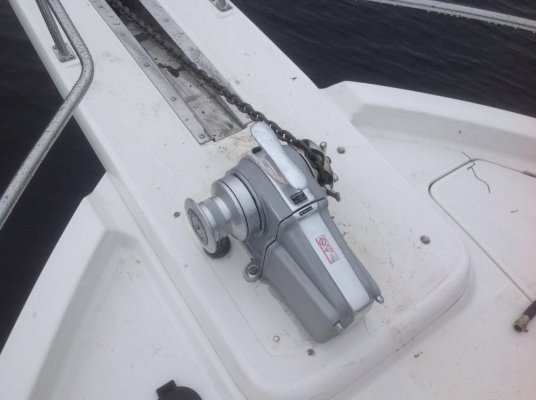One thing my work has showed me over the last bunch of years is that, like it or not, we are well established in a totally global economy. The notion of "Made in USA" or "Made in England" or wherever else one chooses is just about dead. Particularly for complex pieces of machinery be they cars or anchor windlasses.
There is a difference between "Made in USA" and "Assembled in USA" although most manufacturers of consumer products always opt for the former label no matter where the parts are actually made. While I don't know this for a fact, it would not at all surprise me if some components of the "Made in USA" Ideal windlasses are, in fact, from somewhere else.
Boeing airplanes are certainly not "Made in USA." They are assembled here for the most part, but more and more components of them are made in other countries. The entire wing of the 787 is made in Japan, for example. They ship it to us completely assembled in a box. Well, in a Dreamlifter but it's the same idea.
My philosophy is buy the best product I can afford. That's it. I could care less where it's made because chances are it's "made" all over the place. There are parts in a Lofrans windlass that are made in Asia, Eastern Europe, you name it. The windlasses are assembled in Italy and they make a fair amount of the thing from scratch there. But not all of it.
I just bought a new fishing reel for trying a new (to me) style of salmon fishing. Until now, all my fishing reels other than the fly reels have been Penns. Not because they're made in the USA (more and more Penn stuff isn't made here anyway anymore), but because they offered the best value for the money in my opinion.
But after doing a bunch of research and reading lots of industry and user reviews I decided to buy a Shimano reel. This Japanese company has a great reputation and for decades they have been among the top suppliers of high-end bicycle components like gears and shifters and whatnot. So I figured if there's anybody on the planet who knows how to make a small, high-quality gearbox disguised as a fishing reel, it would be the Shimano folks over there in Japan.
So I bought the reel and it is indeed a very high quality piece of equipment. But I was amused to see that it was made in----- Malaysia. I have no problems with this; I just finished a project with a company in Malaisia that makes wing control surface panels for all our airplane models and their work is absolutely stellar. Probably better than would be done here in the US. So I'm delighted that my Shimano reel was made in Malaysia.
But it just goes to show that today EVERYTHING is made where it makes the most economic sense to make it. All the BMW X-vehicles that are sold in the US and this half of half of the planet are put together in South Carolina, not Germany. Nordhavn's are made in Xiamen, China. You can buy Old El Paso Mexican food products in the neighborhood grocery stores in Oslo, Norway. The two most popular brands of vehicles in China are Buick and VW, all of them made there (much to my amazement there are some Buick models made in China that are really good looking, nothing at all like the blah-looking Buicks that are sold in the US).
So I think buying products based on where they're made is rapidly becoming a meaningless exercise.
Then there's the argument that at least the parent company is American. Well, the incorporation papers may be filed in the US but more and more when you start digging into who really owns or controls what, you start finding that even the ownership of US companies isn't necessarily US-centric.
So I'm with Kevin on this one. Buying the best product based on value for money is the smart way to go. Where it's made has become irrelevant. Awhile back Kevin decided he needed a different anchor for the kind of cruising he does. He did his research and determined that the best anchor for the job isn't even available in the US. It's made in Australia and they don't distribute here. But in today's world, no problem. A few phone calls and the anchor was shipped to him in Alaska for, as I understand it, a very reasonable cost, perhaps no different than if it had been shipped up from the Lower 48.
I think this kind of thing is terrific. You can research and shop for just about anything now regardless of where it's made, and if it's not made or even available where one lives, you can have it sent to you with no more effort than if you had ordered it from Amazon.
If the best value for money is a product made in the US, I'll buy it. If the best value for money is a product made in China or Viet Nam or Italy or Russia or Malaysia, I'll buy it. The stereotype of bad quality being synonymous with "Made in China" or "Made in Sri Lanka" or "Made in India" is totally false today. Sure, you can get absolute crap from these countries, same as you can get absolute crap from US manufacturers. Factories make what they are told to make to the quality standards they're instructed to meet.
Buy an anchor windlass that's made in China and discover it's absolute rubbish? Don't go yelling at the Chinese factory about this. Go yell at the American (or Canadian or German or whoever) company that contracted to have the windlass made in China and told the Chinese manufacturer exactly how they wanted it made.


